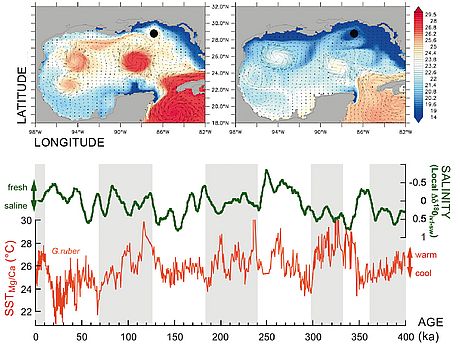Mission:
Understanding climate dynamics and its impact on today’s societies requires a detailed look into the past beyond the instrumental record. The mission of WP3 is to reconstruct the past variability of global and regional ocean circulation from tropical to boreal key regions. This will help to assess causes and consequences of changes in oceanic properties and their response to global, regional and local climate based on proxy records from marine archives on timescales from millions of years to subannual (seasons).
Scientific Questions
- What role does ocean circulation and its interaction with the climate system play in controlling the onset, course and end of warm phases?
- What are the oceanic and atmospheric teleconnections between major ocean basins and between the tropics and the high latitudes? [collaboration with AWI]
- How can marine proxies be optimized and new archives be tapped to reconstruct past ocean-climate states and variability? [collaboration with AWI]
Contents and Goals
The oceans have controlled the dynamics of the global climate on all timescales throughout Earth’s history. However, there is no one-to-one analogue for the unprecedented rapidity of anthropogenically-forced climate change in the last century. Prominent “natural” periods of significantly warmer-than-present phases are seen in past records and prognostic model experiments of anthropogenically-induced future climate change will be evaluated against these past phases. Among these phases, we will focus on the early Pliocene (~4 to 3 million years ago), which represents the most recent period when global climate was on average ~3°C warmer than at present. More recently, the Late Quaternary shows transitions into interglacial warm stages occurring in response to astronomical forcing on timescales of a few millennia, whereas forcing mechanisms such as solar activity have controlled warm phases during the Holocene.
Quantitative information on past natural climatic and oceanic variability is in most cases regional and often lacks global significance. Climatic processes, their natural forcing, the cause-and-effect relationships of ocean/atmosphere interactions, the speed of ocean circulation change, gas and heat exchange, and the latitudinal and meridional climate teleconnections between tropical and boreal regions can thus only be understood if robust information on the ocean/atmosphere system of the past is available. This information needs to be collected for different tectonic and climatic boundary conditions with sufficient areal coverage on the relevant timescales. Precisely dated paleoclimatic time-series from the marine environment are substantially under-represented in key climate assessments (IPCC, 2007, Palaeoclimate chapter), a gap that WP3 will help to fill.
Research Highlight 1: The progressive constriction of the Indonesian Gateway during the Plio-Pleistocene not only led to upper ocean changes in the Indian Ocean but also caused enhanced transport of warm surface waters and heat to the southwest Pacific. The latter was compensated by northward flow of cold and fresh Subantarctic Mode water, which had profound consequences for the inter-hemispheric ocean heat exchange. WP3 will reconstruct in detail past subsurface and intermediate water-mass dynamics controlling and responding to thermohaline circulation changes. The advection of intermediate water masses between ocean basins is key to shaping the physical state of the oceans and their biogeochemical composition. Research will concentrate on the millennial timescale variability and the interactions of the West Atlantic/Caribbean and West Pacific Warm Pool areas and with the high-latitude oceans [e.g., Antarctic Intermediate Water in close collaboration with AWI]. Research cruises to collect new sedimentary records of intermediate-ocean parameters are already scheduled in the equatorial West Pacific and in the Caribbean.
Research Highlight 2: New geochemical proxies for oceanic properties are needed and existing ones need better calibration to enable quantitative reconstructions. This requires detailed knowledge of the distribution, sources, sinks and transformations of trace elements and their isotopes in the present day water column. Even for many traditional geochemical proxies such information is scarce. This gap will be closed within the international GEOTRACES programme. The distribution and mixing of the major deep and intermediate water masses in the Atlantic Sector of the Southern Ocean is reflected in the dissolved radiogenic neodymium isotope compositions, which is a fundamental prerequisite for its application as a paleo tracer for determining the strength of the AMOC. We will focus on the global radiogenic neodymium isotope distribution and its controlling factors. Stable isotope systematics (mainly silicon) of nutrients provide information about their utilization. Most of the proxy development and all low and high latitude teleconnection studies are closely linked to WP3 of Topic 2, and to Topic 3 of the PACES II programme conducted by our strategic partners AWI+HZG.
Research Highlight 3: Atlantic low-frequency sea surface temperature (SST) variability affects climate and ocean changes across much of the Northern Hemisphere, including Atlantic hurricane activity. However, limitations in existing records (instrument-derived and proxy data) make it impossible to decipher the contributions of man-made warming from natural low-frequency climate variability within recent warming trends. The δ18O-signal recorded by a brain coral (Diploria strigosa) at an isolated Venezuelan open ocean site tracks Atlantic hurricane activity during the 20th century. It captures multidecadal variations in North Atlantic SST and is sensitive to changes in vertical wind shear, two important factors influencing hurricane activity. By using corals of this genus, which can live up to several hundred years, we will extend the records of SST and hurricane activity back in time to provide a better understanding of climate variability during the pre-anthropogenic climate state. In addition, cold-water corals will serve to study intermediate water mass dynamics during historical times. These investigations will include high-resolution present day hydrochemical analyses and hydrodynamic observations at the coral sites with benthic lander systems in close collaboration with Topic 2-WP3.



